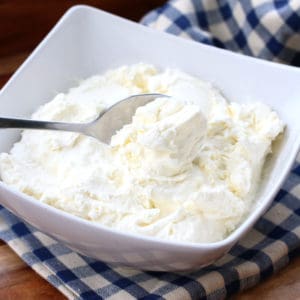
How to Make Mascarpone
Learn how to make mascarpone that's perfectly thick, rich and creamy!
Equipment
- Instant read thermometer (I love my Thermapen!)
Ingredients
- 1 cup heavy cream with NO added ingredients, just cream (fresh/non-pasteurized yields the best results if you can source it; ultra-pasteurized is fine but regular pasteurized is better)
- 1 cup whole milk (fresh/non-pasteurized yields the best results if you can source it)
- 1/16 teaspoon calcium chloride , mixed in 2 tablespoons water before adding it to the cream (not needed if using fresh/raw milk and cream)
- 1/8 teaspoon tartaric acid , mixed in 2 tablespoons water before adding it to the cream
Instructions
- Pour the heavy cream and milk into a small saucepan. Thoroughly stir in the calcium chloride mixture making sure it is fully distributed throughout the cream. Gently heat the cream over medium heat until it reaches 190 F, stirring constantly to prevent scorching. Use a dairy thermometer or an instant read thermometer.Once the cream reaches 190 F adjust the temperature so that the cream remains at 185-195 F and hold it at that steady temperature for 5 minutes.During the 5 minutes dilute the tartaric acid in 2 tablespoons of water. Stir in the tartaric acid mixture, stirring constantly for about a minute. The cream will curdle and take on a consistency of thin cream of wheat. Let it cool for 5 minutes.Pour the thickened cream into a colander that's lined with cheesecloth. Cover it to prevent anything from falling in it and place it in the fridge or in a cool place to let it drain for about 4 hours (or longer) until the desired consistency is reached. Transfer the mascarpone to a bowl. Cover and keep refrigerated. It will keep for 3-5 days. (See also section above about freezing mascarpone.) Makes about 2 cups of mascarpone cheese.Note: This recipe can be doubled.
Nutrition
Serving: 0.25cupCalories: 205kcalCarbohydrates: 2gProtein: 1gFat: 22gSaturated Fat: 14gCholesterol: 82mgSodium: 23mgPotassium: 45mgSugar: 1gVitamin A: 875IUVitamin C: 1mgCalcium: 39mg
Tried this recipe?Let us know how it was!